Let's now explore the proud remains of Málaga
's long Moorish past: the restored Alcazaba and its
uphill partner, the Gibralfaro Castle which is pretty
much in its original condition. The fort itself (see
above picture) appears to be a long curtain wall
frequently interrupted by square towers of various
heights. In fact, it's a double wall with towers spiking
up from both inner and outer walls.
The curtain wall flows downhill making this resemble a
brick dragon sleeping on a hill or perhaps a disheveled
landscape by Georges Braque (a buddy of native
Malagueño Picasso.) The square towers suggest that
these were early fortifications. Eventually towers became
rounded so that battering rams would not have corners to
pulverize. Then attack artillery made both round and
square obsolete - and that happened here in Málaga
almost earlier than anywhere else.
Topology dictates layout

This is the most misshapen fort you could imagine due to
the constraints of the steep terrain. At left is the
Alcazaba, the old fort built at the base of the hill with
the old city enfolding around it. Its problem was that
there was a higher hill to the east (right.) With the
invention of artillery, cannons could be dragged to the
top where they could send their cannonballs into the
Alcazaba. Therefore the Moors (in this case the Nasrid
ruler Yusef I) built a second fort on the higher hill
(the "Gibralfaro") at right. The two were connected by a
zigzag ramparts called the "Coracha." Think of giant (and
grotesquely shaped) barbell sitting on a steep slope.
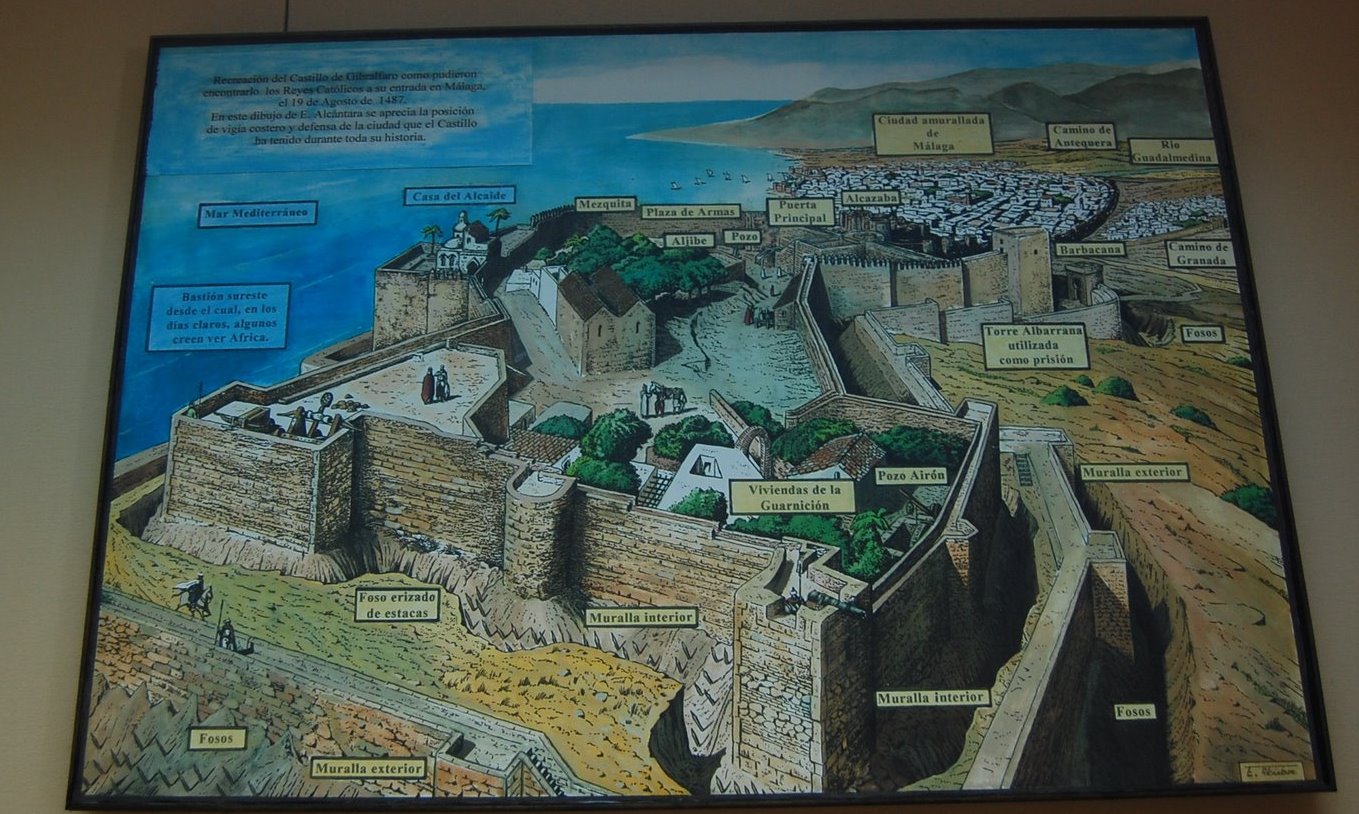
This fortification is really two castles built several
centuries apart. The older, drawn above, is called the
Alcazaba and this view looks down to the foot of the hill
which rises steeply above Málaga. Note how the
Mediterranean (now long receded) then came to the edge of
the fort. Double walls with ramparts surround the entire
site, with moats in some areas. Since each was built at
the then state-of-the-art technology, we see a bit of the
history of medieval fortification with this restoration.
Above we have the older fort at the base of the hill.
It's a quadrangle -- typical of the Moors forts. Its
original intent was to defend Málaga from pirates,
explaining its proximity to the sea. It was completely
rebuilt in the 11th century as the central Moor power in
Córdoba splintered.
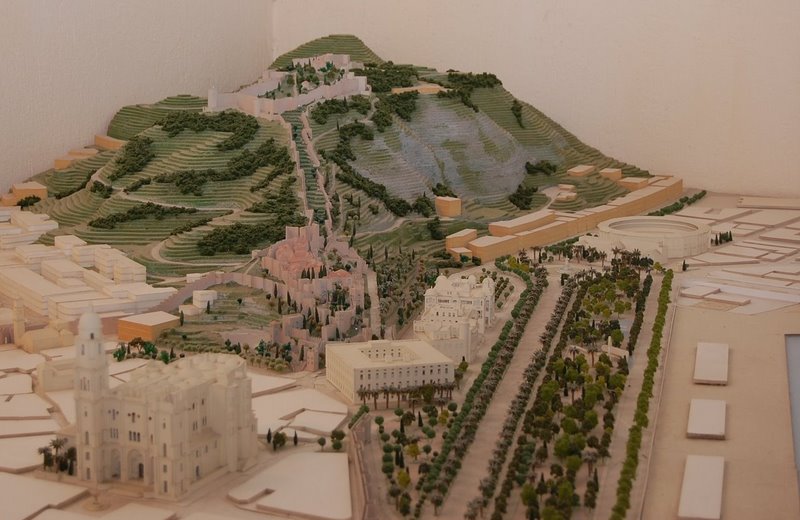
Here's a model showing the cathedral (at 7 o'clock
position), and the older Alcazaba at 6 o'clock) on the
hill. Nearly atop the mountain at about 11 o'clock is the
Castillo (Castle) de Gibralfaro. The spindly double wall
connecting them is the Coracha. Its zigzag shape allowed
defenders to protect it without having to build towers
jutting out from the wall.
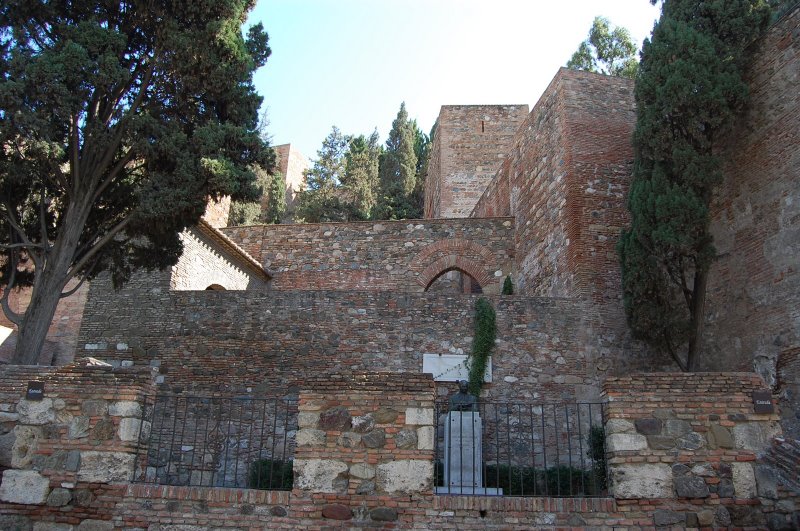
Entrance
Let's return to the bottom of the hill and enter the
Alcazaba. The fort started in the 9th century as a simple
watchtower ("Almería" in Arabic). In the 10th
century, Málaga was enclosed in a wall and this
became a citadel, ushering in the 11th century splendor
of a Taifa kingdom as the central Moor power in Cordoba
deteriorated into multiple city-states. In the tenth
century Abd al-Rahman III surrounded the city with a wall
and built his Citadel. The eleventh century was a time of
splendor as Taifa kings expanded the fort. One of them,
Al-Mutaslm, built his palace within the walls. Centuries
later, Granada's Nasrid kings would revitalize this fort
and palace complex.
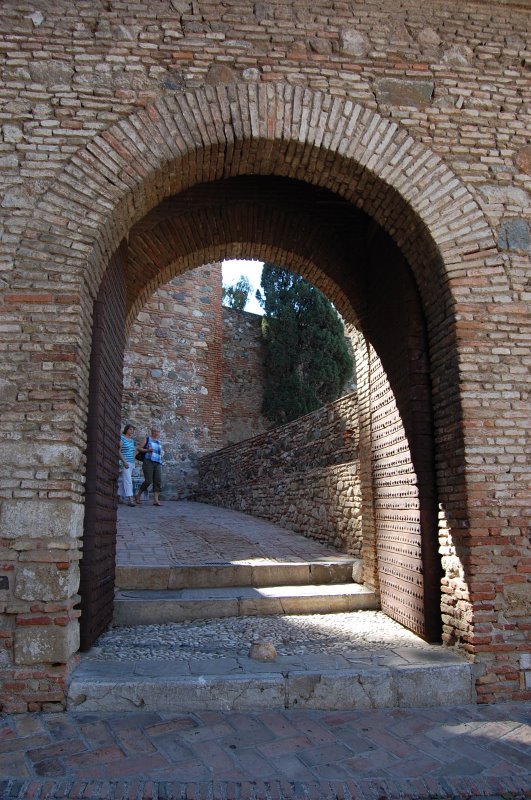
The entrance into the Moorish Alcazaba is protected by a
number of zigzagging curtain walls and gates designed so
that attackers would have difficulty getting any momentum
with either horsemen or battering rams. When the Nasrid
kings upgraded this entrance on an older fort, they added
such then state-of-the-art castle defenses.
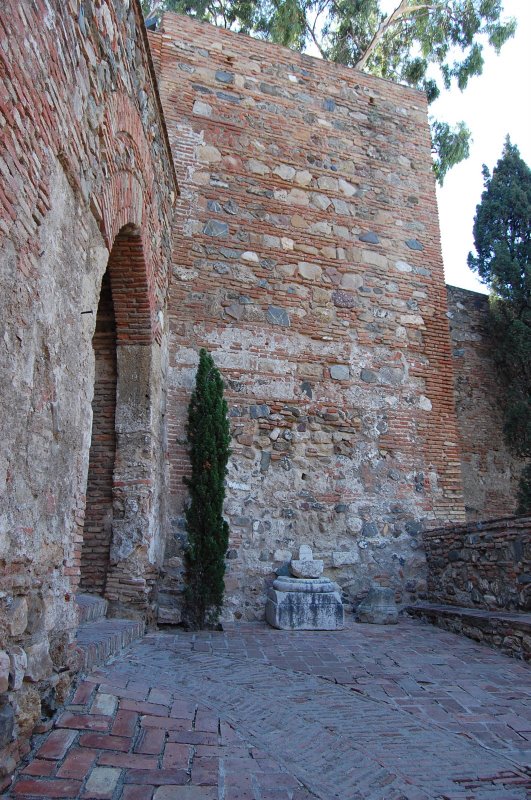
Here's another abrupt turn.
The lower fort was originally built with limestone which
deteriorated quickly in the salt spray. The Nasrid
reconstruction replaced much of this with masonry using
stones as seen here, held together by horizontal layers
of brick. The piece of a pillar here was probably a
remnant taken from the Roman theater below.
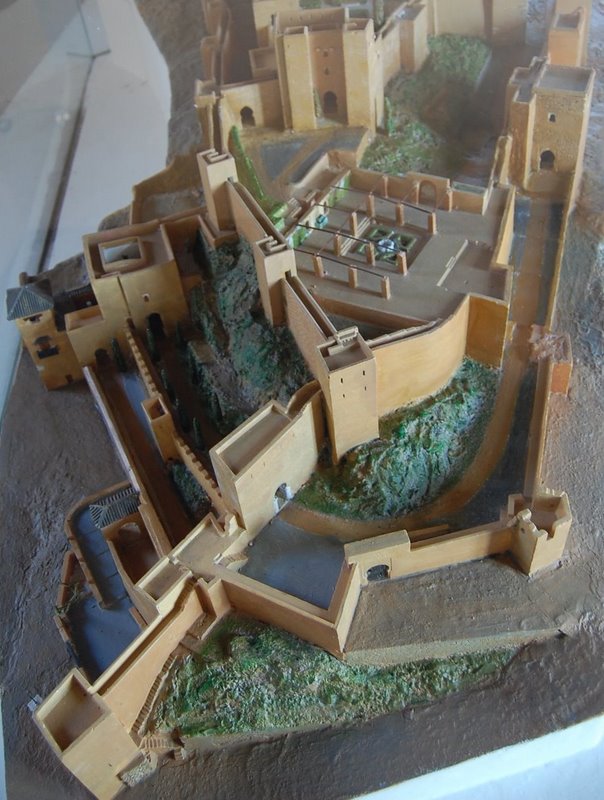
This model shows the set of twisting gates and passages
allowing castle defenders many opportunities to stop an
onslaught before the enemy could reach the flat Patio of
Arms (the garden at top) where the munitions would be
stored in the lower fort.
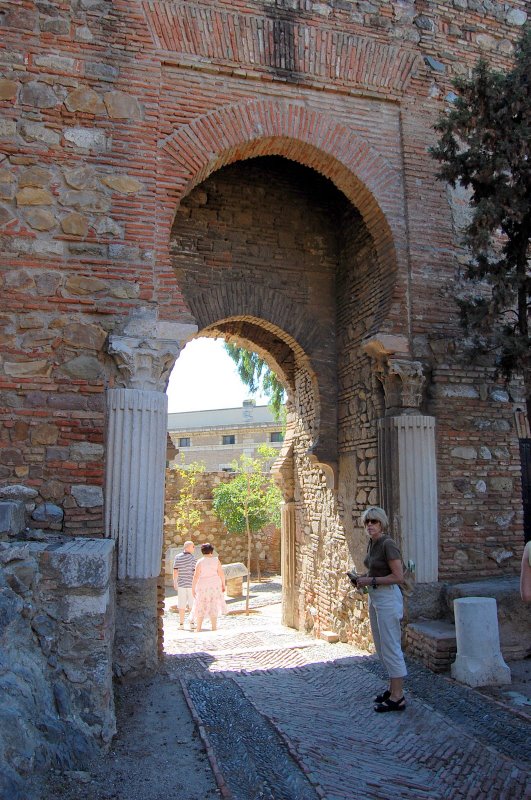
This interior gateway is called the "Puerta de las
Columnas" after its columns (stolen from the Roman
theater at the bottom of the hill.) The walkway doubles
as drainage ditch during rainfall.
Swatting the Sultans
The Sultan who built Málaga 's Alcazaba was Yusuf
I, the 7th ruler of Granada's Nasrid dynasty that ran
what remained of Moorish Spain after the Christians took
the once great city of Córdoba in 1236. While
Yusuf I had great interest in architecture and left some
beautiful works behind in the Alhambra in Granada, his
impact here was more practical. He was fighting the
Christians and needed strong forts to withstand their
sieges.
In 1354, a maniac with a dagger killed Yusuf in a Granada
mosque while he prayed. This explains why so many mosques
have gazebo-like screened areas to protect their rulers
who must prostrate themselves at the conclusion of the
Islamic prayers. Yusuf was 36 years old and was succeeded
by his 16-year-old son. Sultaning was a pretty hazardous
occupation.
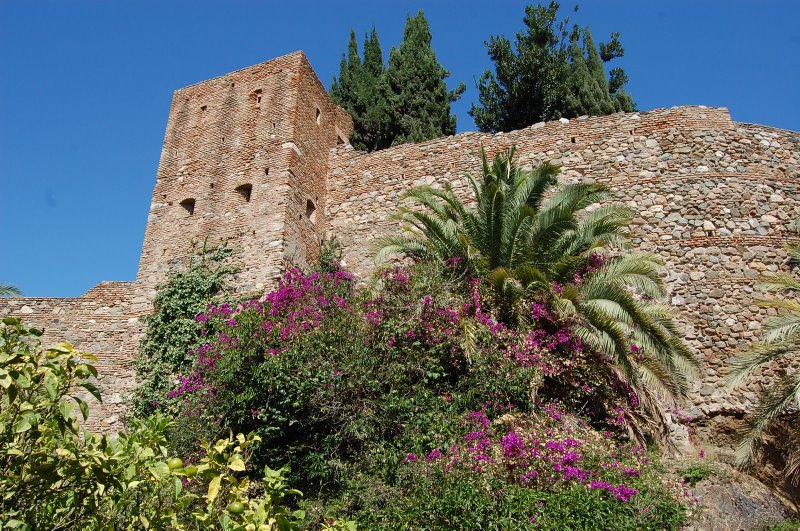
After Yusuf I, the Nasrids continued destroying each
other, allowing the Christians to take their cities
one-by-one. Finally the Christian king of Castile, Peter,
lured Yusuf's nephew who was ruling as Muhammed VI into
his kingdom and subsequently made a gift of his
red-haired head to Yusuf's son Muhammed V -- who was then
restored as sultan of Granada. Pedro, nicknamed "the
Cruel," kept the torso. With family like that, fortresses
such as these don't work all that well.
The Interior
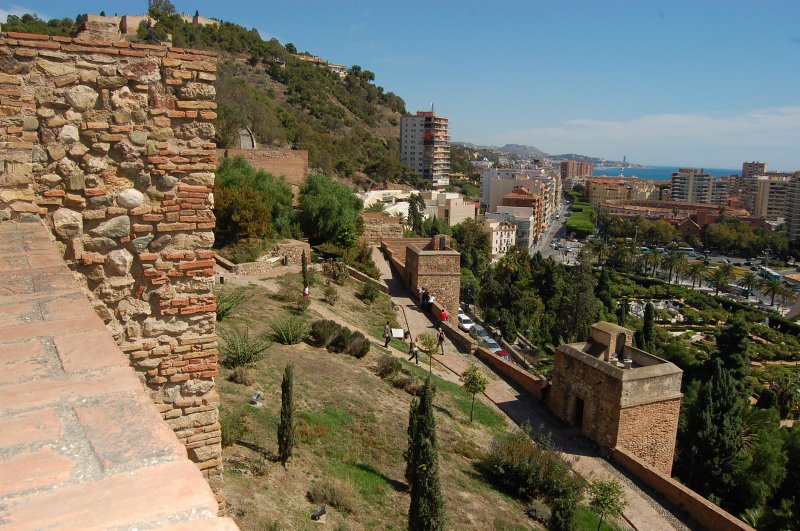
The above view shows an interesting wall at the left,
part of the old lower fortification where brick and
mortar replaced the earlier limestone. This nearly
serendipitous conglomeration of masonry, mortar, and
stone does not make for a pretty castle wall! The newer
fort rises on the mountain at center left.
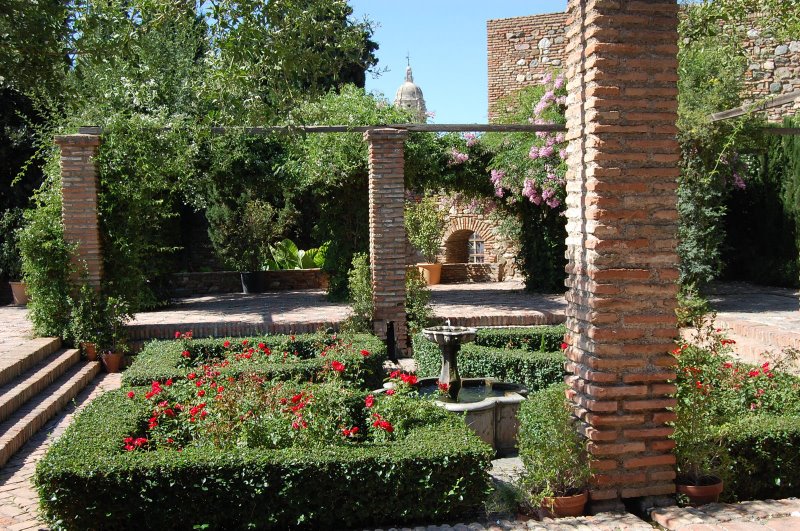
Gardens of various sizes fill the many courtyards as the
fortification climbs the hill. In the distance is the
cathedral's bell tower. This broad and level area is the
Patio of the Arms (Plaza de Armas.)
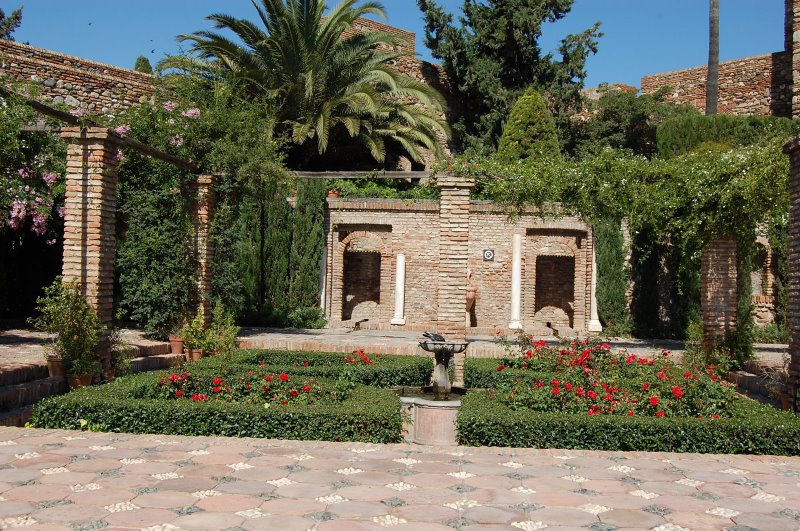
Siege the
day
Fernando and
Isabel conducted a long siege here on their route to the
coup-de-grace at Granada. Isabel personally attended this
siege and stipulated that the soldiers must follow strict
rules against swearing, gambling, and frequenting with
prostitutes. The long siege got even longer! But Isabel
did much for her soldiers including setting up what was
probably the first-ever field hospital. (This probably
was not enough recompense for her conscripting all males
in her kingdom between 20 and 70 years of age to
fight.)
Isabel's presence at Málaga was somewhat unusual
but requested in this case by Fernando: the Moors had
spread a rumor among the Christians that Isabel was
nagging Fernando to withdraw. He wanted to show
one-and-all his Queen's unswerving commitment to
Málaga's capture.
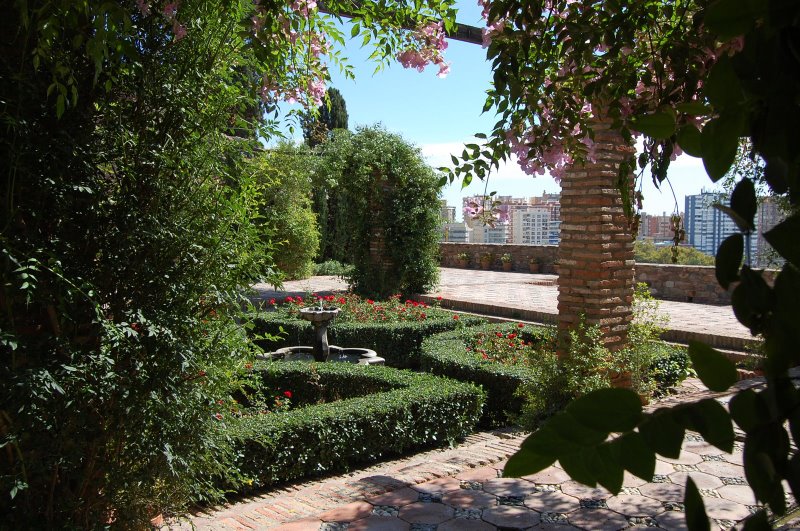
The fleet of Aragon blockaded the harbor and the
Christians were able to defeat the Moors' relief armies.
Isabel convinced her husband to wait, as she wanted to
minimize casualties. Eventually the defenders would be
starved into submission.
A Dervish fanatic convinced the royal guards that he
could prophesy the future for the king and queen; but it
was plot and he attacked them. Fortunately in these
pre-media days, he didn't know what Ferdinand and Isabel
looked like -- and so stabbed the wrong couple. The
Christians graciously returned him to his compadres in
the Alcazaba -- one version says by mule but another more
interesting account was by catapult. Often attackers
would send plague victims over the walls the same way in
the medieval version of biological warfare, long before
germs were discovered. It is possible that the Black
Death which eventually wiped out a third of Europe was
introduced onto the continent via catapult. Are humans
the ultimate weapons of mass destruction?
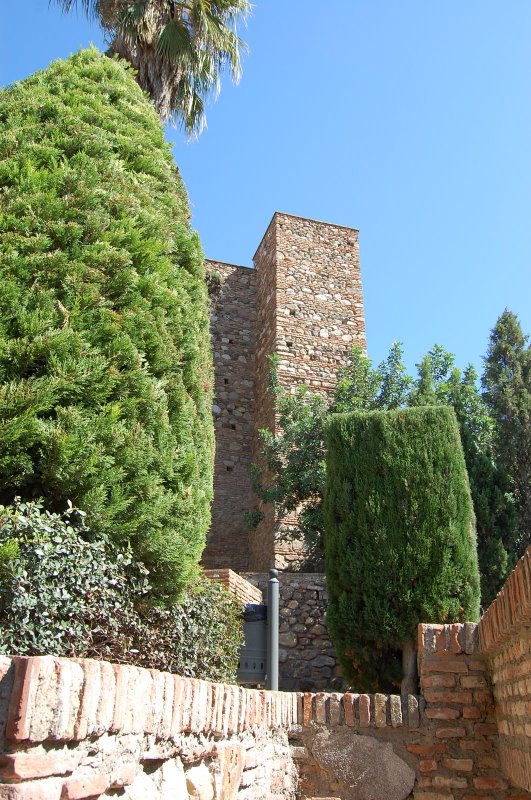
Most medieval war consisted of long sieges against towns.
Most ended with the attackers giving up and leaving or
the town negotiating surrender which gave them many
rights. (Often the Muslims would be allowed to live in
the conquered city under Moslem law.) Not so here where
the attacking Christians numbered 60,000 to 90,000
troops.
But Málaga held out too long and Ferdinand wanted
to demonstrate why that was not a best practice. When
Málaga surrendered unconditionally, Fernando was
brutal.
It was not really the townspeople's fault as they wanted
to surrender early and made sure Fernando knew that
through their emissaries; but the garrison was headed by
an obstinate Moor named Hamet Zeli who refused surrender
for four long months. Grain ran out. The town ate its own
dog food, and then its dogs and horses and cats.
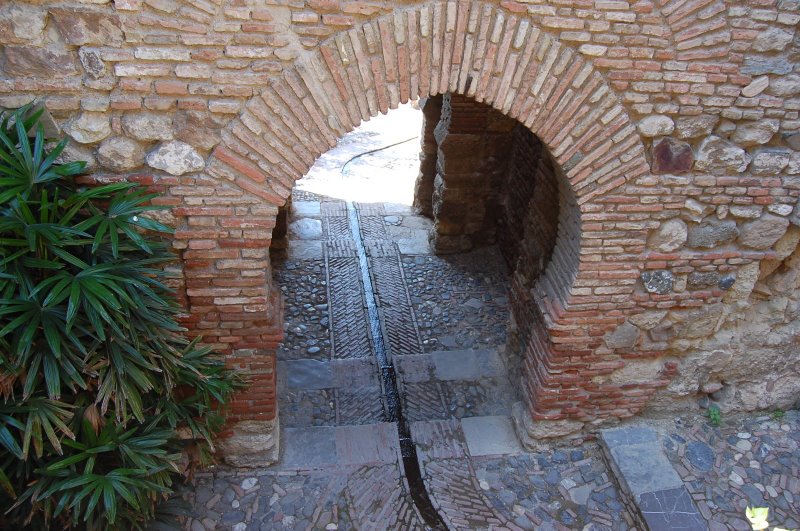
Water, but little food
As in any good Arab garden, water flows to nourish this
urban oasis. This channel starts near the top of the hill
where a 40-foot deep well ensures the castle would never
surrender due to thirst. In fact, this fortress, thought
to be impregnable, held. But blood flowed here with the
water after the surrender to the Christians in mid-August
1487.
Much of the town was enslaved including 50 girls sent to
the Queen of Naples. One-time Christians who had long
before converted to Islam and were called "Renegados"
were tied to stakes and used for target practice. Jews
were ransomed. Fortress Granada watched and learned --
and negotiated a much more favorable settlement to its
siege 4 years later including a favorable exit strategy
for the Sultan.
Fortifications
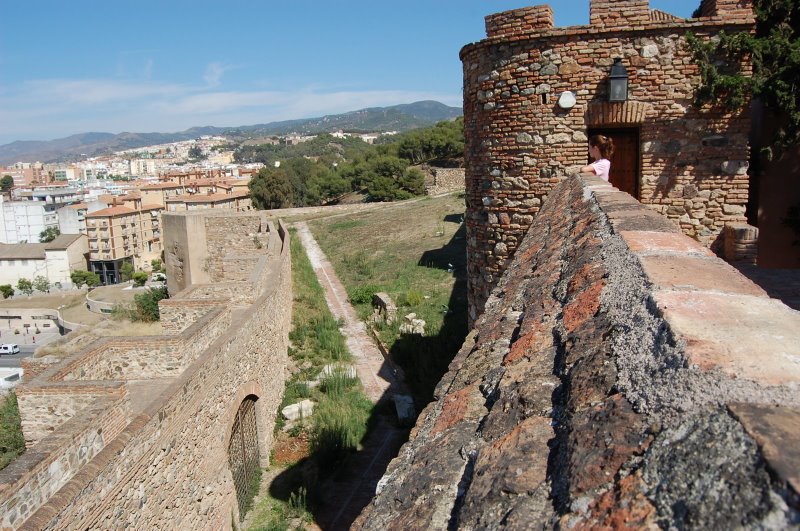
The outer wall (left) and the inner (center). The stubby
merlons at top do not seem to have been fully restored.
But let's look at these crenellations a little more
closely...
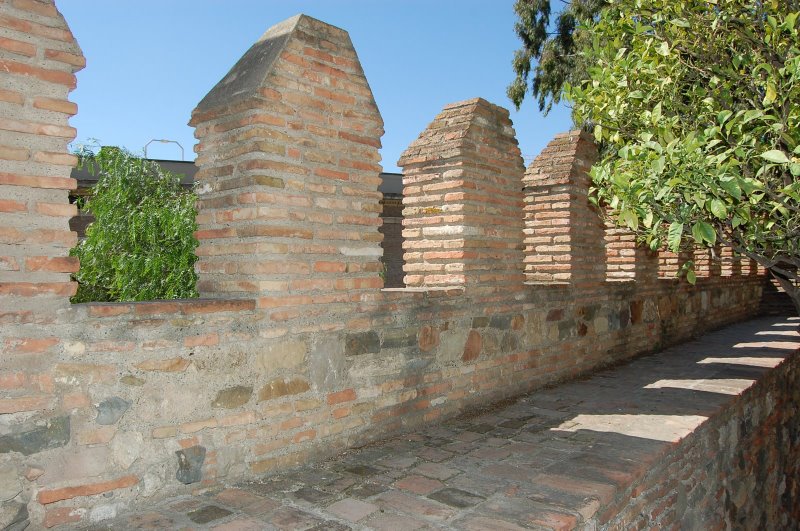
These pyramid tops are typical of the Moors merlons.
These are quite wide; in Roman times, merlons were no
wider than the width of a single defender...

... As defense technology improved and more weapons
needed to be shielded, merlons widened to protect
crossbowman and their larger equipment. Note the square
towers protecting the corners. Behind the modern high
rises of Málaga climb the foothills.
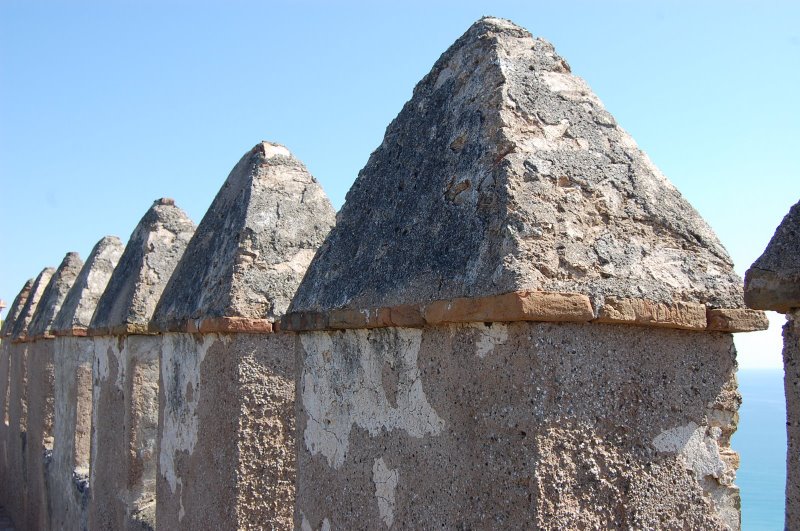
A historical first
A bit of war technology history was made here as many
historians feel the siege of Málaga was the first
time attackers used artillery, which up to that time was
pretty much confined to stationary cannon inside forts.
As siege artillery improved, merlons and castle walls
became obsolete. Queen Isabel --a visionary in many
ways-- was the driving force for introducing the northern
European cannons into the Spanish war of Reconquista. Her
logistical brilliance provided the men, material and road
building needed to transport huge artillery to castle
walls. Her guns were very crude 12 foot-long
rectangular-shaped shafts of iron clamped together in a
circle and called "lombards." Crude but capable of
propelling 140 cannon balls per day up to a foot in
diameter at walls such as these -- if only they could get
into position. The siege of Málaga was a game
changer, not unlike Nagasaki.
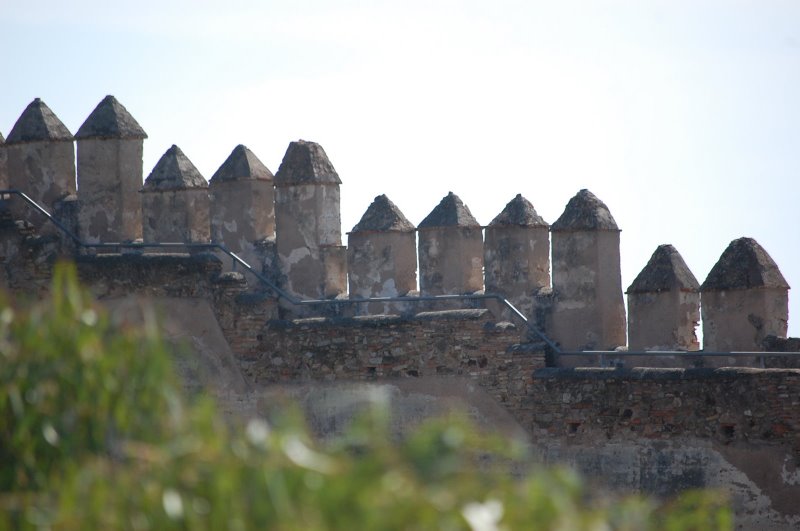
By the end of the war in 1492, Ferdinand and Isabel had
deployed over 200 of those primitive cannons, mostly
hired from Northern Europe. (Ferdinand was smart enough
to couch this as a holy war and got the Pope to pay for a
significant portion of the cost.)
While the offensive artillery had some success against
the outer set of town walls, these inner walls held --
the Nasrid garrison eventually had to surrender or
starve. Napoleon said an army marches on its stomach.
Here the defense failed for the same reason. As they ran
out of food, Malagueños also ran out of
negotiating capability and surrendered unconditionally.
Not a good idea for an impatient King like Fernando who
still had the mighty fortress of Granada to take. He
wanted to set a harsh example of why not to wait out a
siege.

The Palace
But besides being a fort, this was a palace for the
Nasrid rulers when they were in town (perhaps on a visit
or perhaps fleeing their own family members in
Granada.)
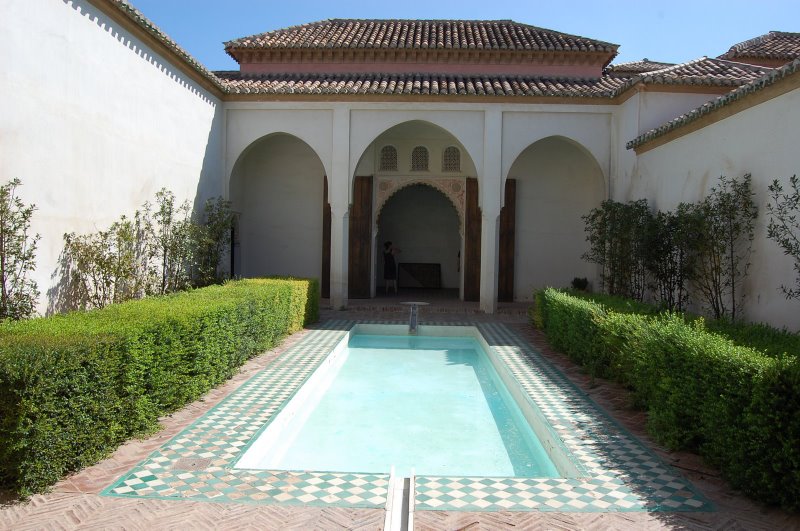
While this is not quite the Alhambra of Granada, it is
considerably less crowded and has much the same layout
including 3 separate courtyards. Unlike the Alhambra, we
find here excellent (even if Spanish only) wall signage
explaining Nasrid architecture and palace life.
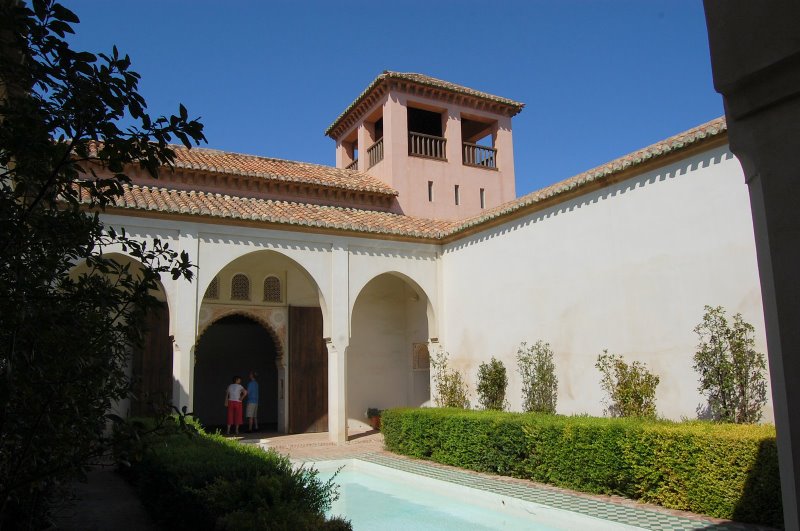
Note the tower above which, with its views -- port, sea,
Africa, Gibraltar -- would provide an even better vista
than the Nasrids had in their headquarters at
Granada.
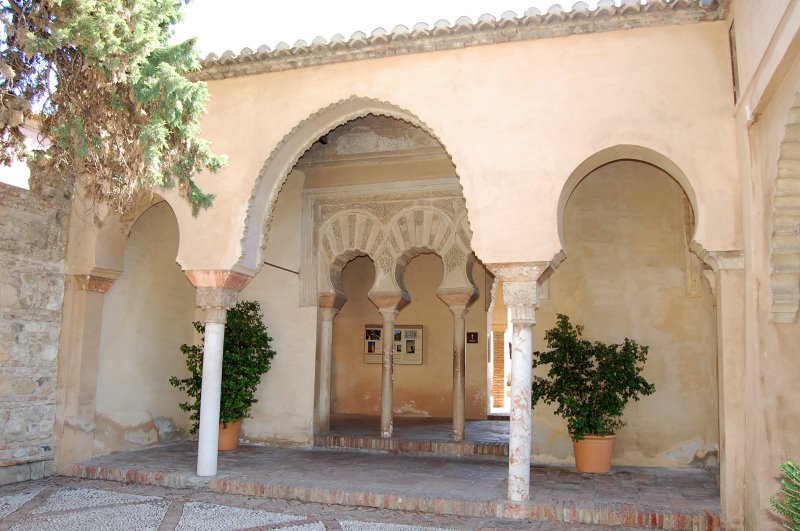
This portico...
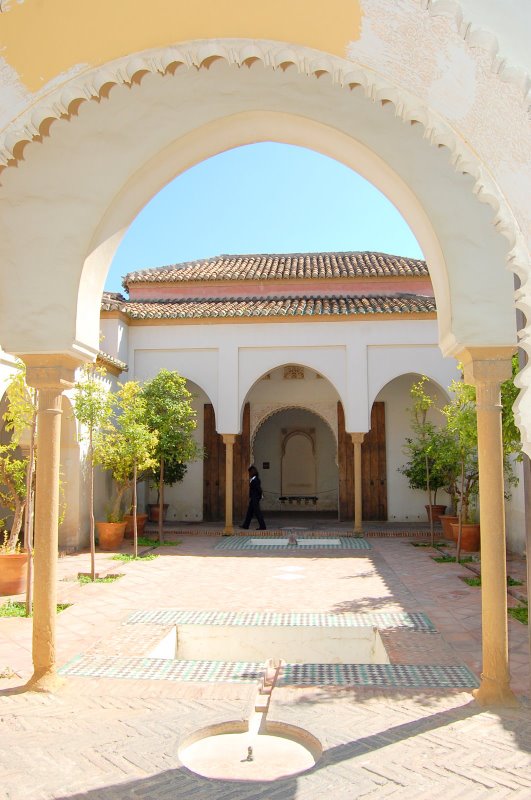
...leads to another of the three courtyards of the
Nasrid Palace. This area also serves as a museum of
ceramics stretching back to Phoenician days.
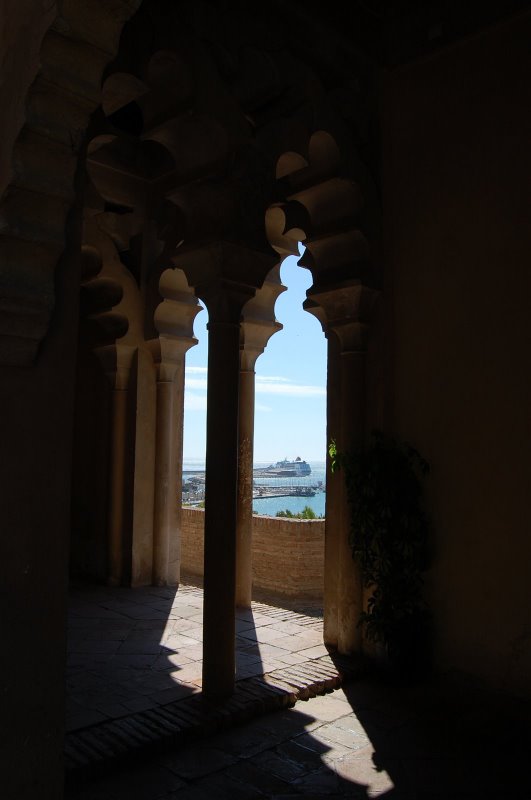
A stop in the scenic mirador gives us two views of
luxury. We stand in the Sultan's viewing point and
see...
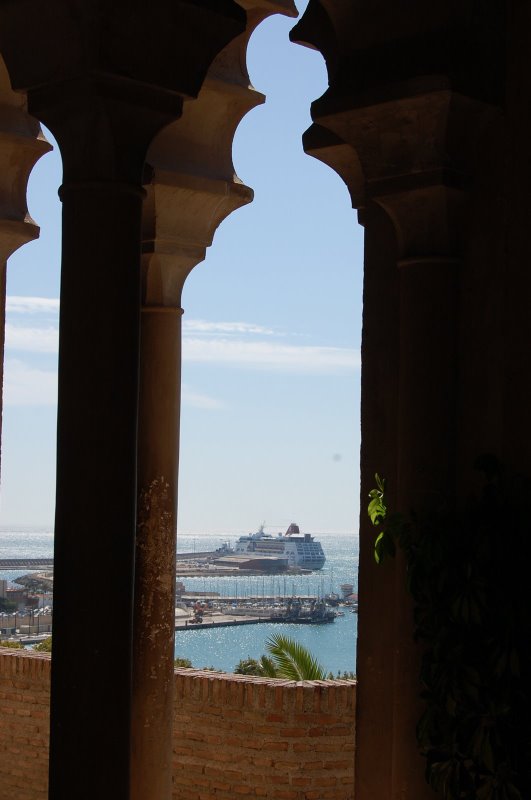
... a distant cruise ship berthed in Malaga's port. If we
only count creature comforts, most of us live better than
the Sultans...
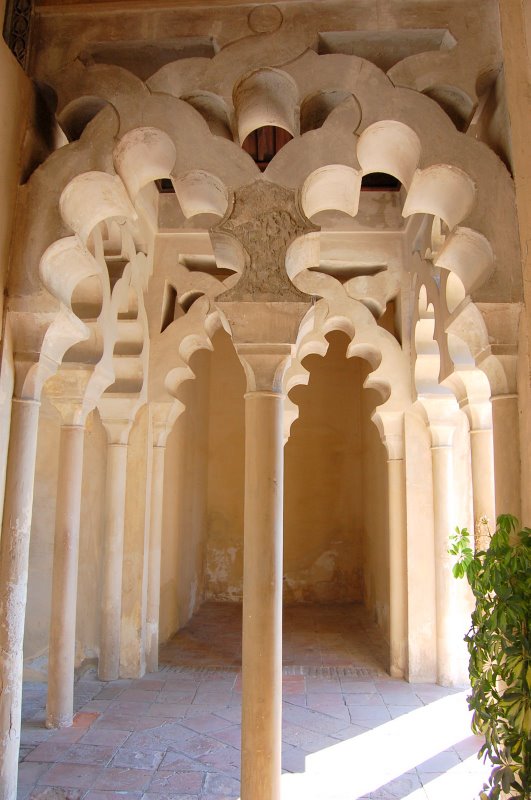
...and our chances of assassination are generally much
less. When this palace was built, most Sultans feared
their brothers. Those in Istanbul eventually figured out
the solution...

... when
they
assumed the throne, they had all of their brothers
killed.
Above and below are close-ups of the pillars and
arches.
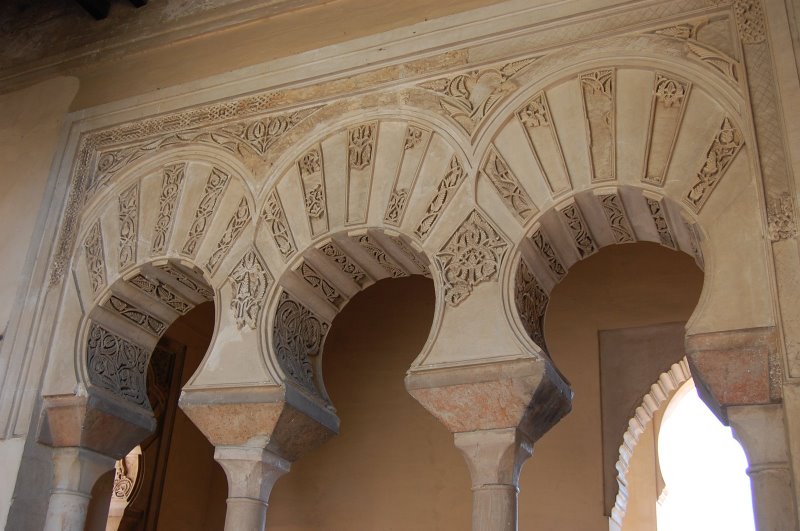
This set of triple arches was erected in the 11th century
as the Córdoban Caliphate disintegrated as a
political power and the Moor states spun off into
city-states called Taifas. Not all of the stucco
decoration has been restored here.
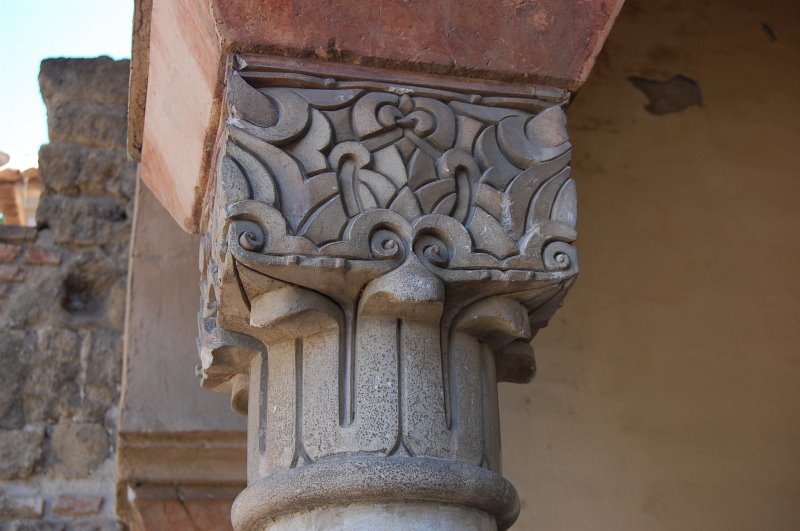
Above this pillar was considerable calligraphy which
typically has not been restored. The ochre support above
it shows faint details of an abacus.
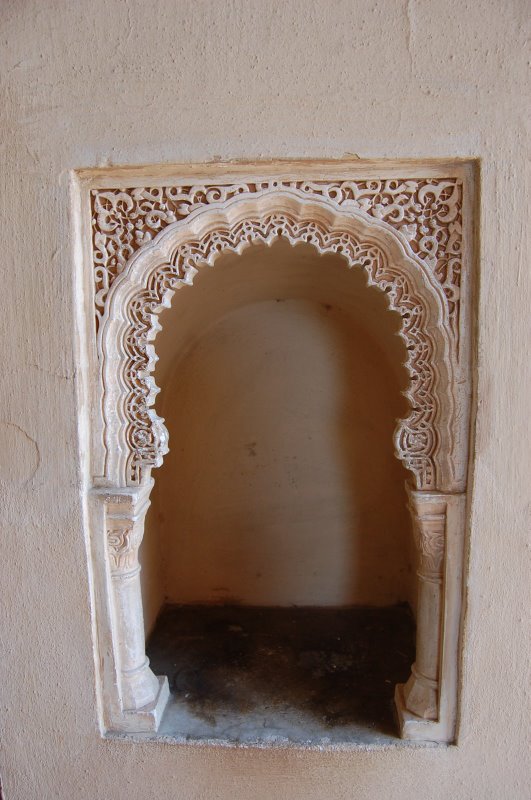
An elaborate multi-lobed portico on a blank, but probably
once highly decorated, wall. This door may lead to the
mirador or viewing tower.
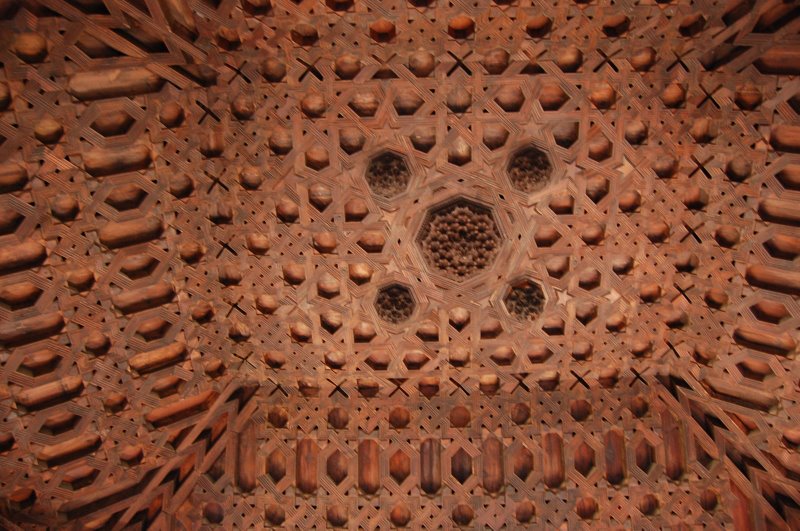
Here's two ceilings, this one the traditional Mudejar
inlaid wood from the 16th century made in homage to the
great ceilings found in Granada's Alhambra ...
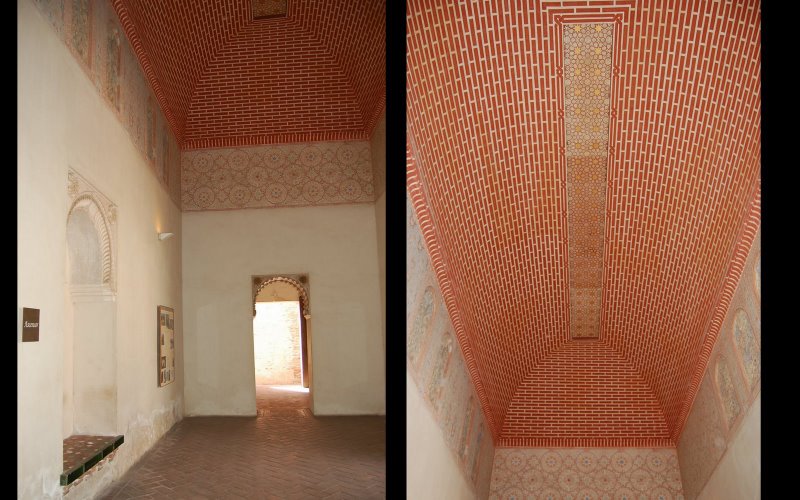
...and the low budget version made of brick (actually
painted brick!)
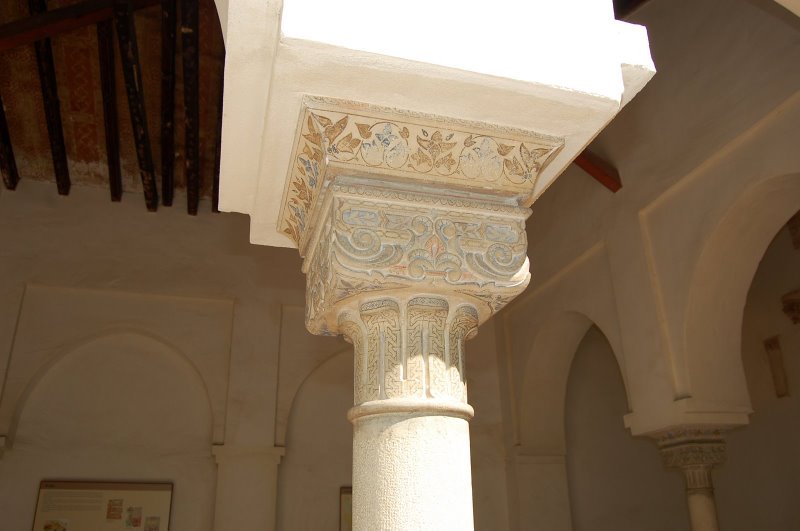
Note (above) the vegetable decorations around the top of
this capital. Above these would typically be calligraphy
reminding the rulers that their power and victories came
from God.
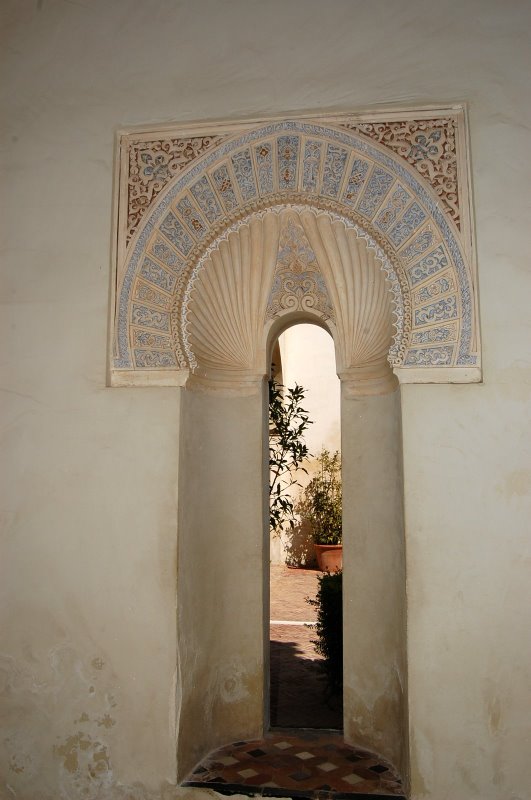
In the rough centuries that followed the collapse of the
Caliphate in Cordoba, Málaga became capital of its
own small kingdom 4 different times.

This area also included Arab baths also fed from the
well. Let's return now to the fortifications.
The Corach
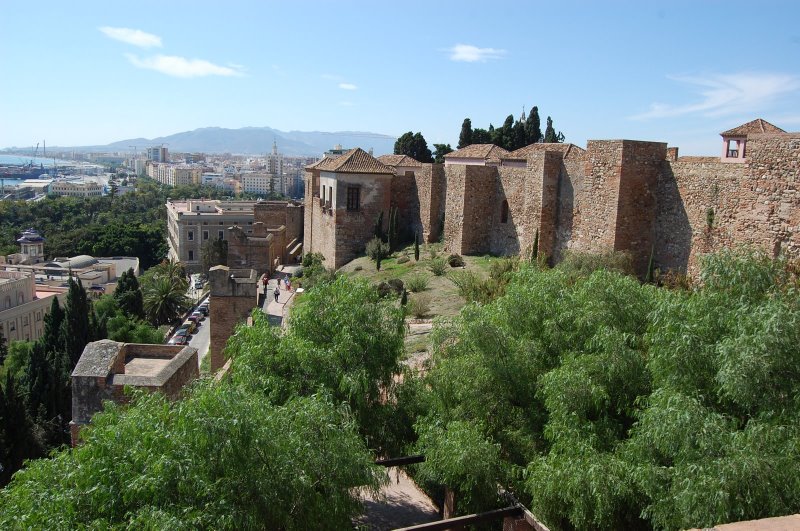
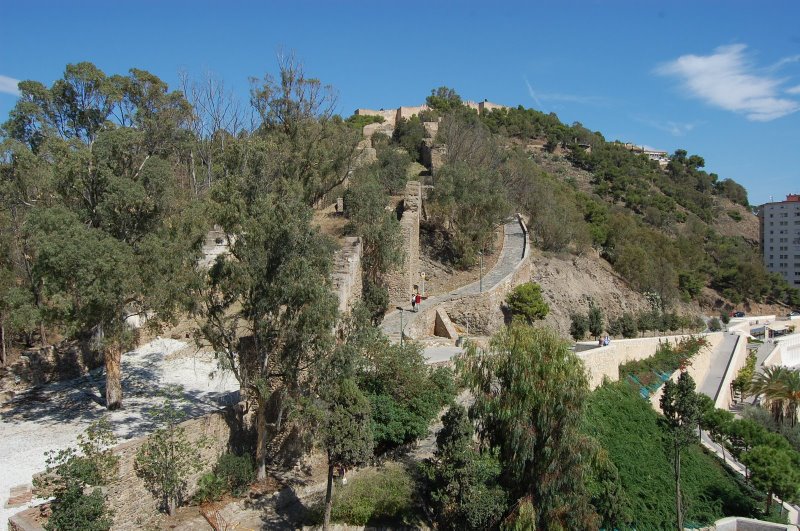
Here's a view of the Corach, the walled passageway
leading from the lower to the upper fort on Mount
Gibralfaro.

Here's a back view of the Alcazaba. The upper castle is
called the Gibralfaro which means "hill of the
lighthouse." The Moors once had their atalaya (signal
fire) at the base of the hill.
The Phoenicians, Greeks, and Romans all had forts on this
site before the Moors built theirs. As late as 1765, one
of these towers was outfitted with a bell to warn
Málaga of pirate attacks. Remember those pesky
Barbary Pirates and the shores of Tripoli? It took 7 US
Marines to do the job on those rascals. Lately we've been
having more help and less success.
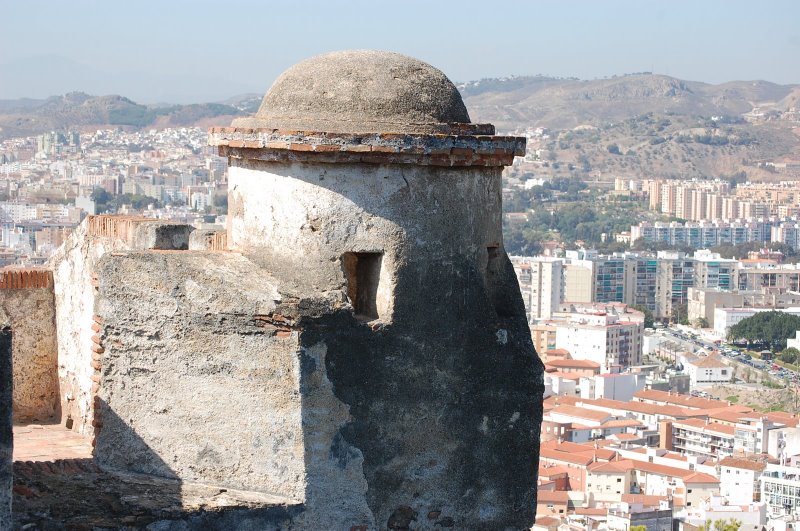
This watch tower still takes a commanding view over
the countryside with its brick-brimmed derby hat.
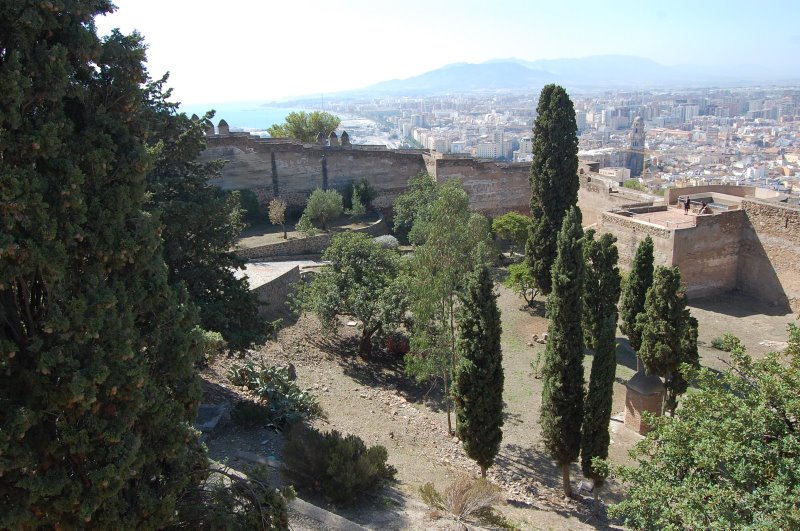
The area of the upper fort (Gilbarfaro) has been restored
as botonical garden.
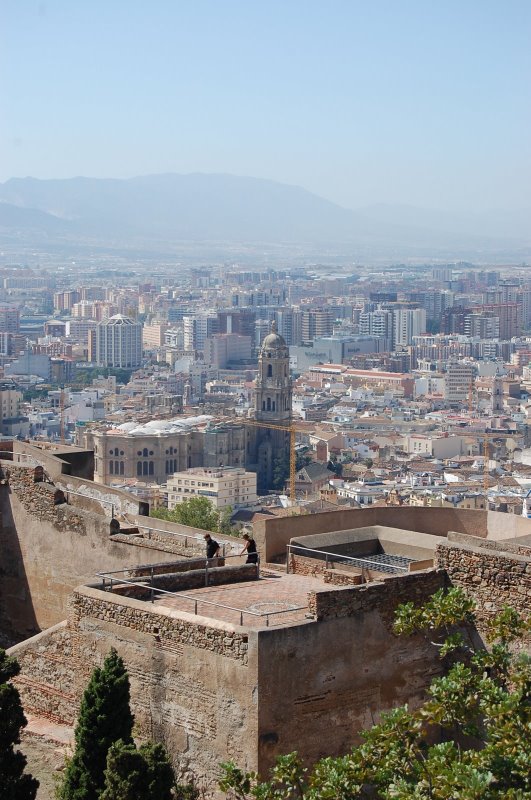
This westward view shows the fortress, the cathedral
beyond, and the mountains hazily in the distance.

The Corach, the long connection between the upper and
lower forts, zigzags down the hill, allowing for its
defense without towers jutting out from it.
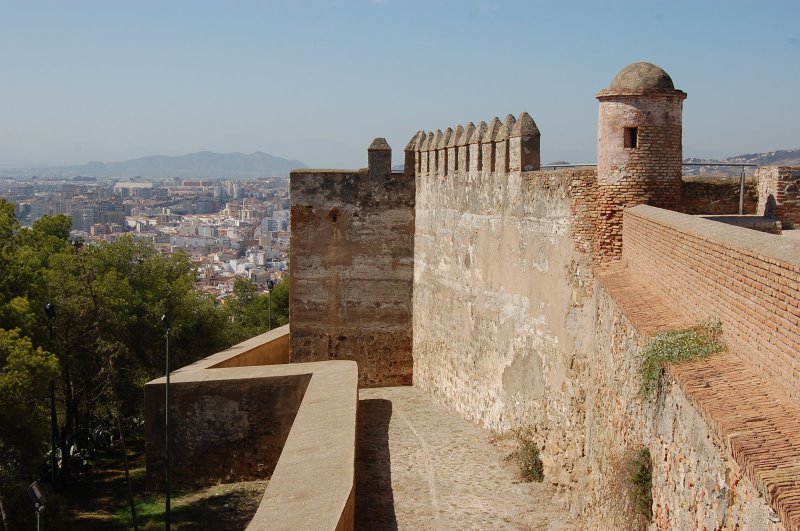
Another view of the ramparts, merlons, and a
watchtower.
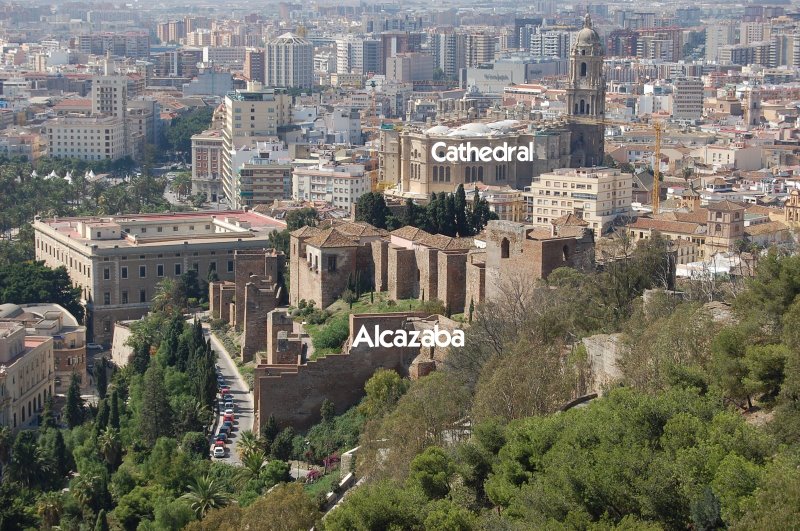
Let's now trek down the hill and check out the
Christian's most important building -- the Cathedral.
Please join us
by
clicking here.
If you have good bandwidth, Please join us in
the following slide show to give the
Málaga, Spain the viewing it deserves by clicking here.
|
|
